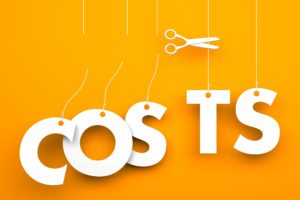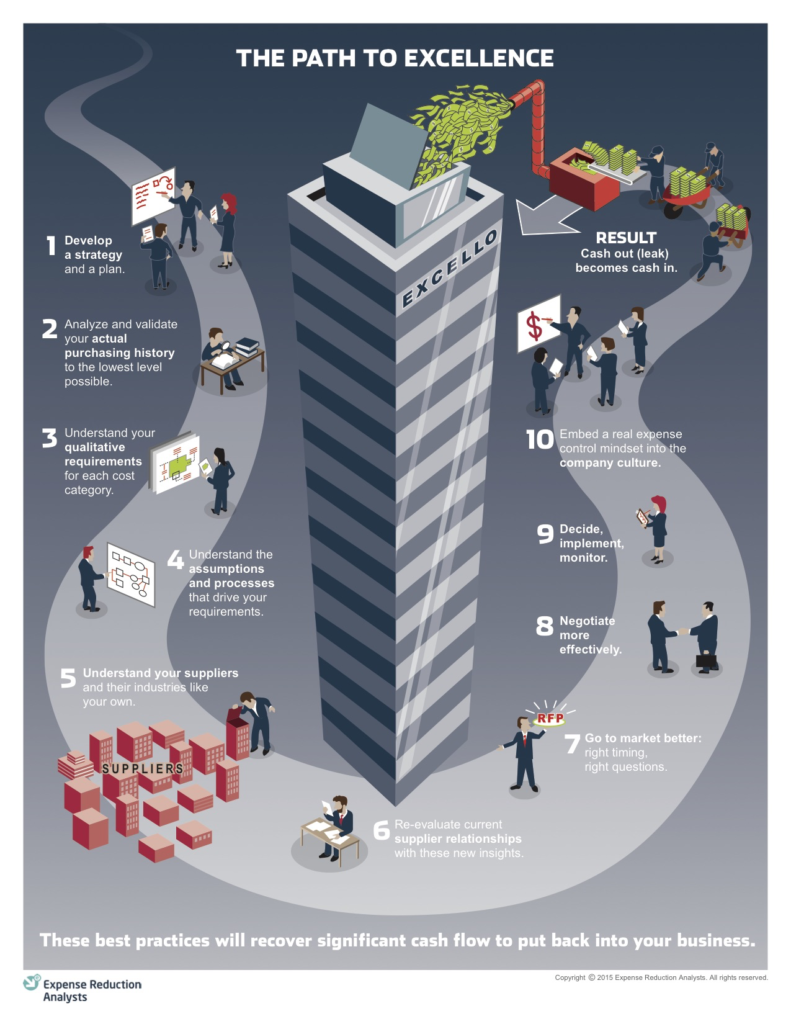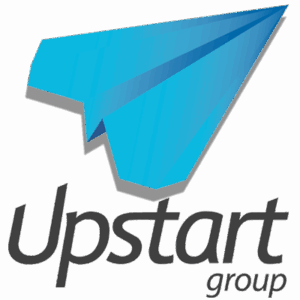By Greg Brown, Senior Principal Consultant at Expense Reduction Analysts
As Acting CMOs for our clients, we think beyond marketing to the total health of a company. We value partners like Greg with ERA who help put additional cash flow to work. Many of our clients have benefited from Greg’s expertise and cost savings. Here he shares merely one example of potential expense reduction in supplier contracts, but there are countless opportunities for decreasing expenses and raising profitability.
-Lynn Fulks, President, Upstart Group
Companies are constantly on the lookout for simple expense reduction tactics. These cost savings efforts often play an important role when organizations are seeking funds for growth, financial improvement, or to fund a specific project.
But how do organizations successfully navigate the path to becoming “Best in Class” at managing expenses? Here are ten steps to consider along what I like to call the “Path to Excellence” in expense reduction:
1. Develop a Strategy and Plan
As your organization works towards developing ways to reduce business expenses, the first steps are to assemble your team, develop a strategy, and implement a plan.
Senior management—including the CEO, CFO, President, etc.—drives the most successful cost-reduction strategies. Cost reduction efforts will be taken more seriously by an organization’s staff when they’re presented as an organization-wide priority to help accomplish a company’s larger initiatives.
To get buy in from staff, management will need to plan out how expense reduction efforts will be communicated to staff and by whom (in cases where this is a cross-departmental effort, the organization’s CEO or President would be an effective point person). Additionally, all members of your management team must be able to answer the key question of why the cost savings initiative is important.

2. Analyze and Validate Your Actual Purchasing History
When it comes to developing a new strategy, it’s important to look at current and past practices first. Start by analyzing overhead expenses to determine bigger-picture spending patterns. Unfortunately, many companies don’t perform this critical analysis due to lack of time and resources – but it can reveal overlooked savings opportunities.
3. Understand Your Qualitative Requirements
Getting the best value from suppliers and vendors isn’t only about price, it’s also about service. To ensure that your suppliers/vendors are providing your organization with optimal service, you need to take into consideration the qualitative needs of your organization and whether they align with your current providers.
This may include:
- Pick-up and delivery accuracy
- Responsiveness to requests
- Expediting procedures
- Ability to proactively suggest purchasing/budgeting efficiencies
Considerations for service-based vendors may be slightly different, so adjust the items on your list accordingly.
4. Understand the Assumptions and Processes That Drive Your Requirements
As your organization has evolved and changed, many of the processes and procedures that initially drove your vendor and supplier requirements may no longer be valid, appropriate, or necessary. As such, it’s important to review current practices versus prior assumptions and processes.
A good place to start in understanding current processes and procedures is to answer the following questions:
- Why do we make purchases in this way?
- Who initiated this process? How long has it been in place?
- Do we know how our processes and procedures impact other departments?
5. Understand Your Suppliers and Their Industries
Now is also the time to better understand a supplier or vendor’s perspective and the factors that drive their profitability. Suppliers and vendors appreciate clients that are well-informed about their respective industries because they’re typically easier customers with more realistic expectations. Proactive collaboration with suppliers/vendors can reduce the cost of doing business through process improvements which make you a more attractive and profitable customer.
6. Re-evaluate Current Supplier Relationships
When reviewing your incumbent suppliers or current vendors, it’s important to keep the process objective – especially since your organization may have developed some long-term relationships.

As your organization is evaluating suppliers or vendors, it’s important to ask:
- Is the supplier/vendor interested in our organization’s challenges and plans for growth?
- Is the supplier/vendor an active partner in the success of our business or only visible when renewing a contract?
- Is the supplier/vendor a close relation (or friend) of someone on staff? If so, does this impact business decisions?
This process should foster an open conversation for stakeholders to determine whether incumbent suppliers and current vendors are meeting your organization’s business needs.
7. Go To Market Better
If your organization is ready to consider new suppliers or vendors, keep your highest priorities in mind as you solicit proposals. Each year, organizations should review their suppliers and vendors and decide if it’s an opportune time to explore other options, as the marketplace is always evolving. Each supplier/vendor has different strengths, and finding the right solutions for your organization means that you get better service at better prices.
8. Negotiate More Effectively
Once you receive proposals from suppliers and vendors, there’s usually room to negotiate. To do so effectively, it’s important to make sure you’re performing a true comparison across the various contenders.
Whenever possible, make sure all of the proposals you receive include:
- Best and final pricing
- Itemized pricing for each service/product
- Itemized fees and charges
- Itemized delivery charges
Outlining pricing in this way ensures that you understand each supplier/vendor’s underlying costs, which ultimately affect which one your organization chooses. These requests may be more appropriate for suppliers than service vendors, so adjust your requirements appropriately.
9. Decide, Implement, Monitor
Once you’ve made and implemented your purchasing decisions, review the results over time to document actual savings versus your category baseline. Make sure to account for new changes or requirements as needed over time.
After a favorable contract has been implemented, another important step is to prevent price creep from setting in. Regularly reviewing invoices can help keep costs in line. When reviewing supplier invoices, keep an eye out for:
- Pricing errors
- High price/high volume purchases
- Change in product mix
- Off contract purchases
Vendor invoices will differ in nature, but should also be monitored for consistency in pricing and compared against the original proposal/contract.
10. Embed a Real Expense Control Mindset Into Your Company Culture
Making an effort to reduce business expenses within your organization by implementing the steps outlined above can be a catalyst in creating a larger culture of cost reduction that can be maintained within your organization for years to come.
Once you’re in the monitoring stage, you have the opportunity to maintain staff involvement (and interest) in long-term cost-reduction efforts. This can encourage staff to continue finding ways to incorporate cost-reduction best practices into their day-to-day tasks and share these practices with others.
Implement Smart Expense Reduction with the “Path to Excellence” Infographic
For a cheat sheet on this 10-step cost-savings process, check out this handy infographic!

Get in touch today to learn more about how I can help implement significant savings for your organization. For support with marketing budgeting and planning, Upstart Group is my trusted partner.
 Greg Brown is an expense reduction consultant with over 10 years of experience supporting clients in the Manufacturing, Life Science, Healthcare, Financial Services, and Private Educational industries. As a Senior Principal Consultant with Expense Reduction Analysts, Greg has successfully coordinated the efforts of their team of expert Project Analysts on 194 different projects, delivering additional cash flow for 62 separate clients over the past decade.
Greg Brown is an expense reduction consultant with over 10 years of experience supporting clients in the Manufacturing, Life Science, Healthcare, Financial Services, and Private Educational industries. As a Senior Principal Consultant with Expense Reduction Analysts, Greg has successfully coordinated the efforts of their team of expert Project Analysts on 194 different projects, delivering additional cash flow for 62 separate clients over the past decade.


